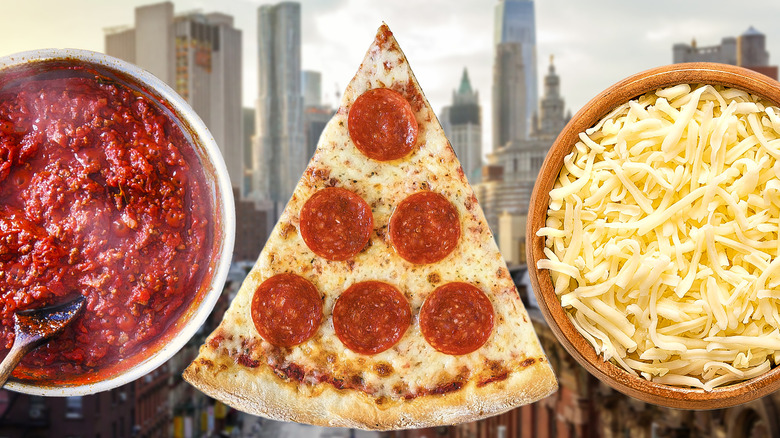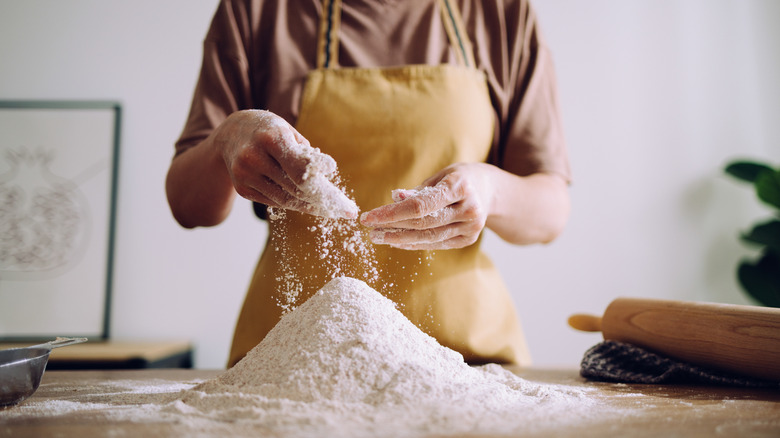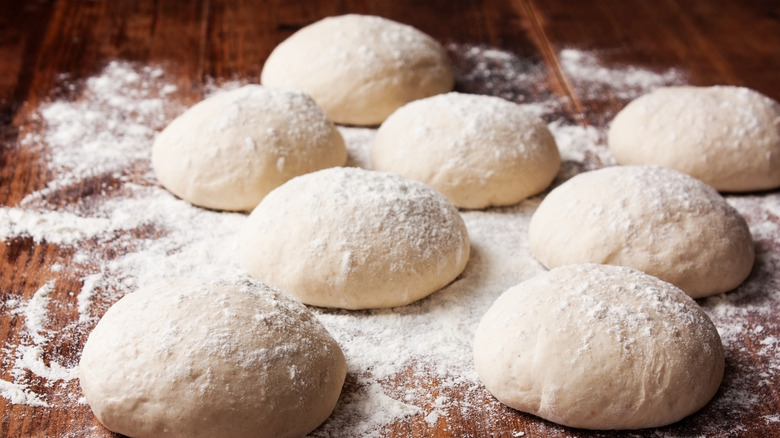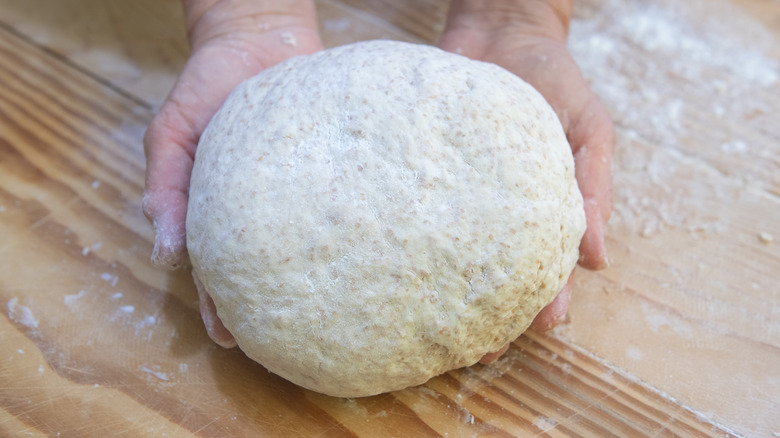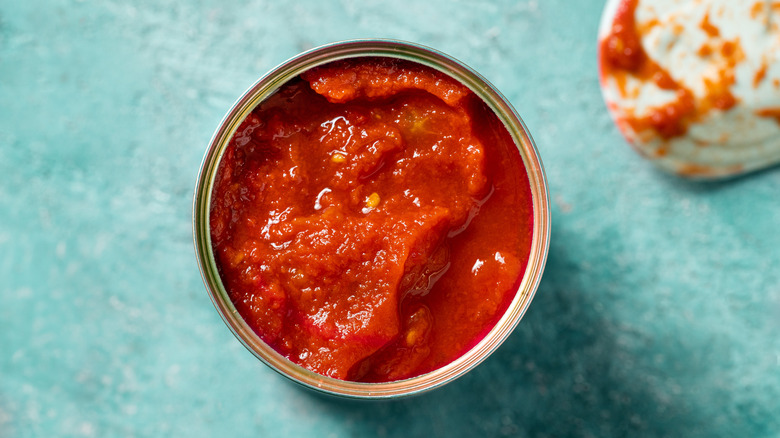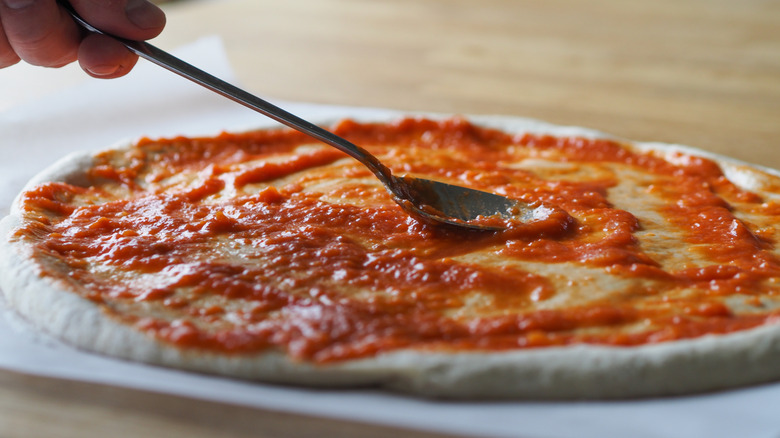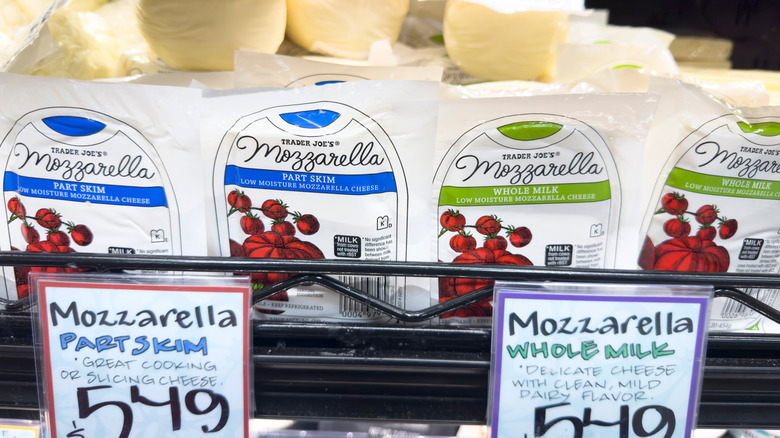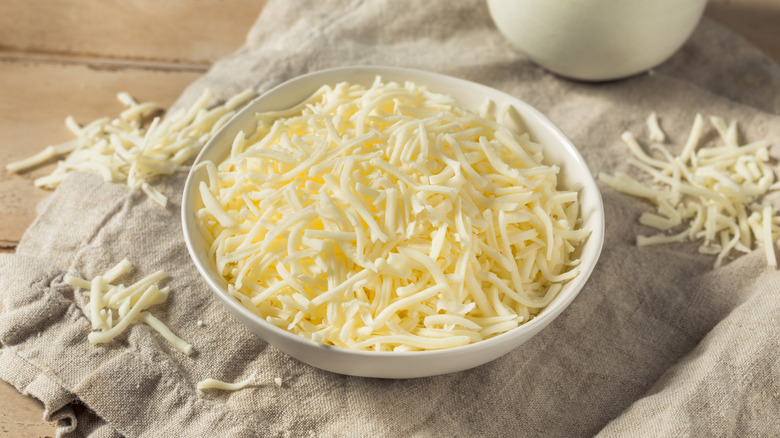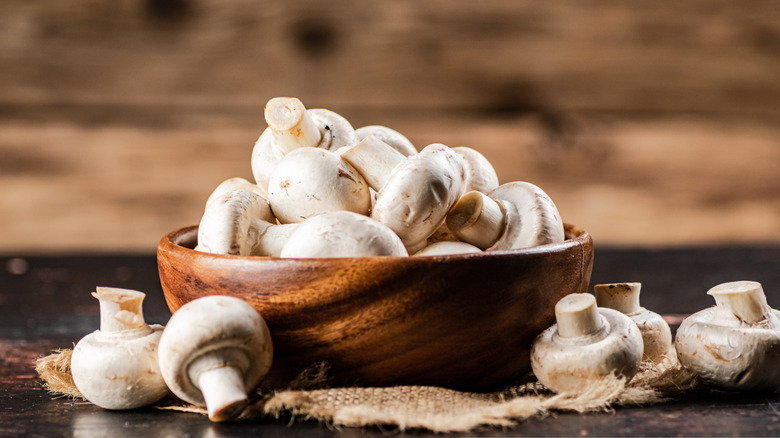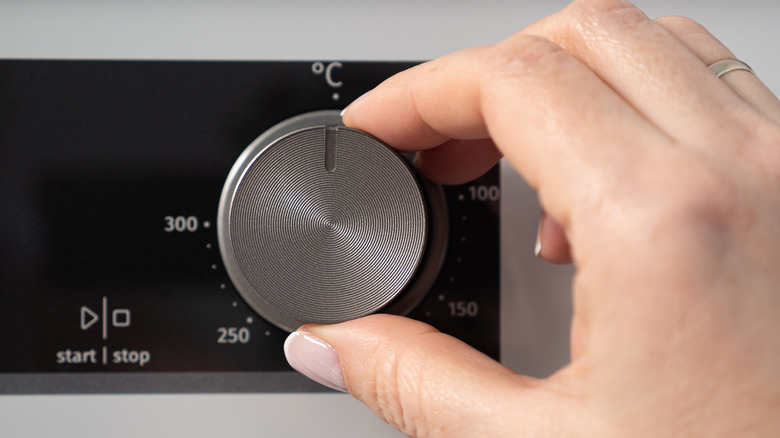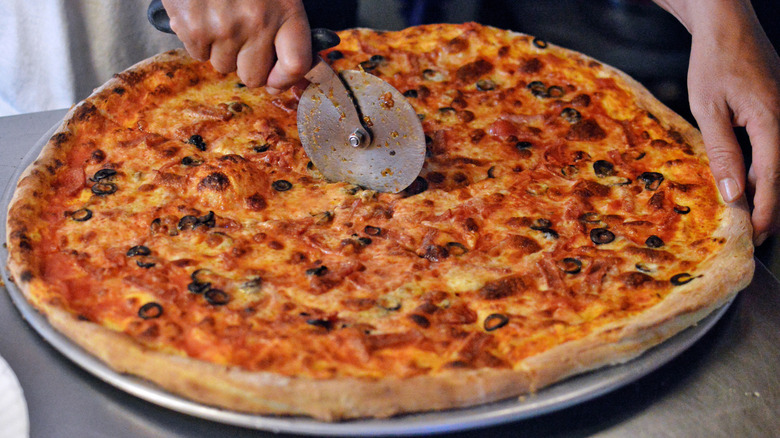11 Tips You Need When Making New York Style Pizza
We may receive a commission on purchases made from links.
New York style pizza is a classic. It's rich, chewy, crispy, and salty. It's easy to see why this classic urban snack has become a mainstay not only in its hometown, but also across America. And it is important to specify its hometown, says Mark Bello of Pizza School NYC: "New York is a big state and the pizza in Buffalo is definitely different than the pizza in the five boroughs." For that reason, they specify "New York City style pizza" in their teachings. Dealer's choice.
It's also super portable. The traditional slice is easy to fold in half (or not!) and eat on the go, thanks to a specialized crust that lends stability. Sold by the slice, it is often bought, paid for, and eaten without ever sitting down. Plus, as Blaine Parker of Free the Pizza explains, "It's designed to reheat well and it feeds a crowd. New York style pizza is an evolution from Neapolitan pizza, which is a small pizza designed as a meal for one to be eaten as soon as it emerges from the oven." What's not to like?
Making it at home does require a bit of an update over the traditional pizza with a thicker crust, though. That's why we sat down with several pizza makers to get their take on dough, sauce, cheese, toppings, and everything else. Accordingly, here are 11 tips to take your New York slice to the next level.
1. Use a high-gluten flour
One of the biggest pizza-making mistakes is to use the wrong type of flour because that can lead to suboptimal crust results that don't align with New York style standards. "Probably the most distinguishing thing about New York Style is the crust does not bend," says Michael McCoy, founder of Prepa Pizza. That way, you can "fold and carry it with you without having to eat it on a plate." Since the ability to eat on the go is a classic distinguishing factor, you can't wing your flour choices.
High-gluten flour is the answer, giving you a lot of structural integrity from the more substantial protein content. It makes for a nice, stretchy dough, which will lead to that classic chewy texture and crunchy, crispy bottom. "The result is that the NY pizza is a bigger pizza with a crust that's more structured and more durable, and lends itself to reheating," Blaine Parker says.
General Mills All Trumps flour is a good high-gluten flour, but it's a bit difficult to source since it's mostly used by professionals. It's available online in 50-pound bags, so if you're serious about a good crust, it's probably worth the investment. If you're not sure, you can buy a 25-pound bag instead, but you don't get as much bang for your buck. If you're going to buy regular flour, you need to make sure it will provide the same structure so that you can stretch the dough nice and thin, per the standard New York style pizza directions. To do this, you can add vital wheat protein. All you have to do is check the gluten content of your flour and the content required in the recipe, then make up the difference.
2. Add less water
One of the biggest secrets your favorite NYC pizza spots are using relates to moisture, or "hydration," as it is known to experts. Pizza crusts use different amounts of water to achieve different crust results. For instance, Sicilian style and Chicago deep-dish pizzas both use low amounts of water, from 50-57%. New York style commonly opts for 60%, as do many types of conventional pizza (think the ones you order for delivery). Higher-hydration doughs, around 70%, lead to soft, supple, easily charred results, good for a wood-fired pizza oven.
As for New York style, says Michael McCoy, "The lower hydration allows for the crispy but still chewy bottom," so it's important to get it right. That way, you get a stronger crust that won't flop over on you. However, Mark Bello points out, "As much as there is a science to dough, there is also a sensibility. Ultimately, we dial in the hydration of our dough in response to ambient factors such as temperature, humidity, altitude, etc. The dough we make with our students in our NYC classroom in hot, humid August comes together differently than in cold, dry February." For that reason, he likes to say that New York style pizzas are 60(ish)%, leaving room for the chef's instinct.
The best way to control hydration, in addition to adding the olive oil that is standard to New York style crust, is to use dustings of flour while kneading the dough to the proper consistency. "Think slightly tacky but not sticky and bounces back like a Tempur-Pedic mattress when poked," Bello says. This intuitive approach allows chefs to create a crust of the right consistency anywhere, "whether they live in the desert or the tropics or a few thousand feet above sea level."
3. Ferment your dough for a long time
Although there's a myth that the signature flavor of New York style pizza comes from the city's tap water, that's not true. This crucial factor actually stems from the preparation of the dough, specifically, the fermentation process used by the chef. If the fermentation process is too short, you won't develop that signature taste, which is a pizza shop red flag.
"Probably the biggest mistake that even loads of restaurants make is serving a same-day or next-day dough, which does not allow a proper fermentation," Michael McCoy explains. "So the dough is very bland and boring to eat." A significant fermentation time of at least three days is important for getting the right texture and flavor to your dough. This gives the yeast time to break down and creates that zingy, slightly sour flavor that is key to a good New York style pizza. Also, too short a fermentation time means "the flour has not been broken down properly by the yeast, so now your body has to break that down." For the gluten-intolerant, this is a meaningful factor, as sourdough is more digestible than plain bread.
For new pizza makers, overeagerness is a common mistake. "The resulting pizza is very unsatisfying," Blaine Parker says. "The secret is patience. Long, cold fermentation is your friend when making pizza dough, especially at home." So don't skimp on time, people; ironically, it's not the New York way for pizza.
4. Opt for a simple tomato sauce
There are a thousand answers to the question of what constitutes a good sauce. Top chefs hold firm that the secret to a good pizza sauce is that it must be raw, period. This means using a can of crushed or puréed tomatoes or crushing canned, peeled whole tomatoes by hand, then seasoning them and spreading the result on your pizza. Heat need not apply. This is as true for the New York edition as any other.
The good news is that a good sauce for your New York-style pizza is dead simple. "Too many prepared pizza sauces are filled with all sorts of subpar ingredients, sugars, and syrups, while the better-quality stuff costs exponentially more than this simple and awesome sauce," Mark Bello says. The correct ratio is one 28-ounce can of good-quality puréed tomatoes (sub crushed for a more rustic sauce), 1 teaspoon salt (optional), 1 teaspoon sugar (optional), 1 teaspoon garlic powder, and 1 tablespoon dried oregano. "You can mix this sauce up directly in the can. Just be sure to transfer the leftovers to a nonreactive container at the end of your pizza party to refrigerate or freeze for future use."
The pizza sauce should focus on that rich, delicious, low-water tomato taste. Most folks achieve this with plum tomatoes, San Marzano being the gold standard. However, more affordable puréed tomatoes will do just fine. Bello adds that you should check the can to see if it already has salt. If so, skip adding it, as most pizza toppings are salty anyway.
5. Go light on sauce
As important as sauce is, you shouldn't use too much. New York pizza is meant to be carried with you, after all, so it's critical that it's not too heavy. This is why most pizzerias are light on the sauce. A 28-ounce can of tomato purée is enough to top six pizzas, which are usually large, around 18 inches, the better to make for big, meal-sized slices. According to the math, therefore, you should be using around 5 ounces of sauce per pizza.
When applying, go for a thin, even layer of tomato sauce. If you want to take a more intuitive approach, just make sure you can't see the sauce underneath the cheese, advises Michael McCoy. With a reasonable spread of mozzarella (though not enough to make the pizza too heavy or cause the cheese to fall off), you should render the sauce invisible.
6. Use low-moisture mozzarella
All right, you made it to the most important part of the piece, in this writer's humble opinion: the cheese. Because isn't cheese what we're really doing here? As with everything else, though, it's important to get this ingredient right.
"For the classic NYC slice, we gravitate toward whole-milk, low-moisture shredded mozzarella," Mark Bello says. "Some pizza makers are partial to part-skim or a blend of whole-milk and part-skim," he continues, but unfortunately part-skim browns faster than whole-milk. For that reason, "skim cheese can brown and toughen before the crust gets a proper bake." Since you're making pizza in a home oven with reduced heat capability compared to a commercial restaurant, you need to give your pizza enough time. Thus, whole-milk mozzarella is the way to go.
People watching their waistlines needn't worry. "Calorically, whole-milk, low-moisture mozzarella averages 80 calories an ounce, whereas part-skim is around 70 calories an ounce. Whole-milk mozzarella melts better so you can use less to get the proper coverage and thus the calories even out." Lastly, while low-moisture mozzarella might sound like a fancy specialty item, it isn't. It simply means the mozzarella you find wrapped in plastic, like regular cheese, rather than sitting in water. While fresh mozzarella is delicious, its high-water content isn't ideal for New York style pizza, though you'll find it on a Neapolitan.
7. Don't use pre-shredded cheese
This is more of a general pizza tip if you're using mozzarella: Don't use pre-shredded cheese. It usually contains some type of starch, officially dubbed "anti-caking agents," to prevent the cheese from sticking together, Mark Bello explains. The starch also extends the shelf life. While these might be benefits for grocery store owners, however, they can prevent your cheese from melting nicely. Moreover, Bello says, "It is not a plus for flavor and texture."
Bottom line: You've got to grate it yourself. One of the reasons people tend to avoid this is that even dry mozzarella can prove frustrating to grate, as it's rather soft compared to, say, a block of cheddar. To work around this, Bello says, "Put the block of cheese in the freezer for 15 minutes to firm it up for shredding, and use a good shredder because a sharp knife is safer than a dull one." He recommends this Microplane grater if you're in the market.
Make sure, too, that you don't overload the cheese. Now, you can still add a lot of cheese to a New York slice, but the most important tip is to make sure it's still portable. The defining characteristic of this pizza is that you can carry it with you without worrying about losing your lunch (literally), so don't go hog wild.
8. Experiment with toppings
Although many people think of cheese and pepperoni when they envision a New York slice, you can add toppings to good effect. At the risk of sounding like a broken record, just make sure not to weigh down your pizza, which can compromise its portability. In addition to being heavy, some toppings are very salty (like pepperoni and anchovies), so don't use too heavy a hand.
In terms of what toppings to use, pizza makers have their own ideas. "I'm a purist and think that the classic cheese slice is the best test of any great pizzeria," Mark Bello says. "Past that I'm partial to mushrooms and/or sausage." In addition to watching out for topping weight, he adds, use a restrained hand with variety as well. "Too many flavors on a pizza can confuse your taste buds and cancel each other out." So, how should the home chef approach topping experimentation? "The checkboxes on the front edge of a classic pizza box constitute a good list of the usual suspects," he advises. Typically, they include peppers, onions, anchovies, meatballs, and the aforementioned mushrooms and sausage.
"FYI, pepperoni is the most popular topping in the United States," Bello adds. At Pizza School, they love their pepperoni and don't turn up their noses at a vegan pepperoni either, which he says, "even hardcore carnivores agree is pretty tasty."
9. Cook at a lower heat
Another distinguishing factor of New York style pizza is the heat at which it is cooked. Indeed, heat is a critical factor in any type of pie. For instance, Blaine Parker says, "True Neapolitan-style pizza is baked in a 900-degree wood-fired dome oven. It bakes in about 90 seconds." On the other hand, "A New York-style pizza is typically baked in a large, gas-fired or electric deck oven, around 550 to 650 degrees for about 6 minutes, give or take. It's ultimately going to depend on the oven, the topping load, and the degree of doneness desired."
Most home ovens will go up to 500 or 550 degrees Fahrenheit tops, so you'll have to adjust your expectations somewhat. Happily, New York pizza is pretty forgiving, and it loves being baked. In fact, Parker says, "If we're talking about pros, I would say they often don't bake the pizza for long enough. The browning of the crust brings flavor." Too often, though, even pizzeria crust is pale. This is often the result of a pizza joint being too busy to dedicate the proper cooking time, which is necessary to give the pizza time to dry out and get a crispy bottom, both ideal for that portable pizza style. Thankfully, this is not an issue you're likely to have at home.
To help your pizza along with the cooking process, it's a good idea to use a pizza stone. The stone holds heat for a more even cooking process, and it draws water from the dough to help create the perfect crisp. You can find a good stone for grilling or baking pizza online.
10. Make the slices larger
Whether we're talking regular ol' New York style pizza or subgenres such as Brooklyn pizza (spoiler alert: there's really no difference), there's one unbreakable rule when you cut it: The slices must be large. The pizza itself is large, so to a certain extent the slices will be long no matter how many pieces you choose, the result of the larger circumference.
"As far as classic NYC slice pizza goes, it's eight slices for an 18- to 20-inch pizza, or sometimes even bigger," Mark Bello explains, though of course that's up to you. "To quote the late, great Yogi Berra, 'You better cut the pizza in four pieces because I'm not hungry enough to eat six.'" To make nice, neat pieces, use a sharp pizza cutter. And, as this writer discovered not too long ago, you can use a pair of sharp kitchen shears to cut through any spots you missed with the pizza cutter.
If you don't have the ability to make a pizza that big at home, that's okay: there's a hack. You can cut one giant wedge out of the middle by starting at one side and cutting at an angle all the way to the other, minus the ring of crust. Repeat at another spot on the crust to make a long triangle. Leave the smaller pieces for later ... or for children.
11. Fold away! If you want to
This is less a tip about making and more a tip about eating, but tomayto, tomahto. The question is: to fold or not to fold? Blaine Parker cringes in his reply: "Wow. You really want to get people coming to blows, don't you? I've been known to fold. My wife believes the fold is a crime against pizza. The only rule here is that there are no rules. Do what makes you happy."
Michael McCoy, on the other hand, takes a firmer stance. "While it is your pizza and you can do whatever you want, the history of the New York slice is that it's for someone on the go. It's how you make sure you don't lose any of the cheese, sauce, or toppings along the way." In his opinion, if you're moving, you should be folding.
When making pizza at home, you're probably less likely to immediately step out the door carrying your slice, but then again, you might be one motivated chef. In that case, you might consider a box of wax paper sheets to help you keep the mess contained. Last but not least, if you prefer eating your pizza like a sandwich right at home, with the crust on the outside and the gooey goodness on the inside, no one's going to stop you!
